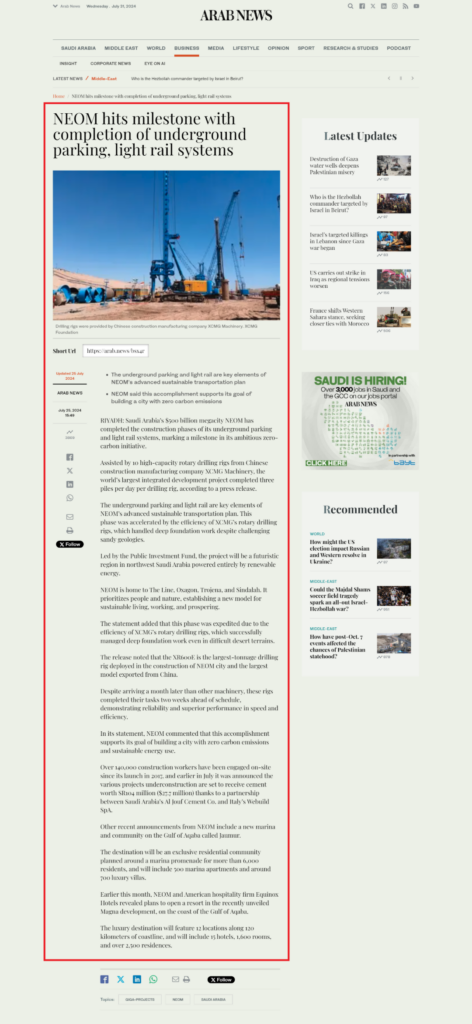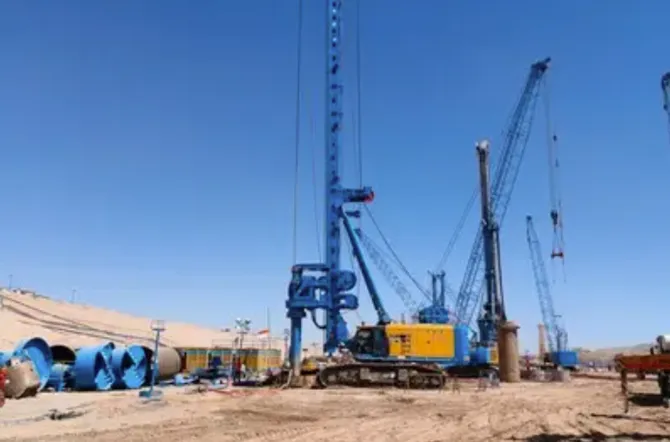Saudi Arabia’s $500 billion New Future City (NEOM) project has achieved phased results, with the construction of underground parking lots and light rail systems completed, ahead of schedule.

NEOM, which is managed by the Saudi sovereign fund Public Investment Fund (PIF), will be a future city in northwestern Saudi Arabia powered entirely by renewable energy, with underground parking and light rail being key elements of NEOM’s advanced sustainable transportation plan.

In the process of completing the node targets ahead of schedule, there are many Chinese companies at the NEOM construction site, such as XCMG, which provides mechanical equipment.
Despite the complex local geological conditions, each drilling rig of XCMG can still complete 3 piles a day. Although these drilling rigs arrived a month later than other mechanical equipment, they completed the task two weeks ahead of schedule.

XCMG said they deployed 10 large-capacity rotary drills at the construction site, including 4 XR500E, 2 XR600E, 2 XR320D and 2 XR400D drills, handling piles with a depth of 60 to 90 meters and a diameter of 2 to 2.5 meters.
The XR600E is the largest tonnage drill deployed in the construction of NEOM and the largest model drill exported by China.
The new future city consists of four main planning areas, namely The Line, Sindalah, Trojena and Oxagon. The first tourist area is also expected to open to tourists in 2024. 95% of the area in the new future city will be designated as a nature reserve. Among them, The Line will be a linear city with a height of 500 meters, a width of 200 meters, a length of 170 kilometers, and an exterior wall surrounded by mirrored glass.
The mystery of the project progress
In the past few months, there have been reports or doubts that the progress of NEOM will be delayed. In early December last year, Saudi Finance Minister Mohammed Al-Jadaan said that Saudi Arabia would postpone some projects in the economic transformation plan until after 2030.
In addition to financial factors, other reasons include avoiding huge inflationary pressures and supply and demand bottlenecks, as well as taking longer to build factories and cultivate sufficient human resources. Mohammed Al-Jadaan believes that the decision to extend the construction period of these projects is reasonable. He also pointed out at the time that after reviewing the project schedule, some projects may be postponed for three years, some projects may be postponed to 2035 or later, and some projects will be streamlined.
But Jadaan did not disclose the specific names of the postponed or optimized projects at the time.
In April, media reports said that PIF had cut the financial budget for the NEOM project this year at the beginning of the year, and the overall progress of the project was also delayed. This large city, which was originally planned to move in 1 million residents and receive 500,000 tourists in 2030, has shrunk in the new plan, and internal estimates show that the actual number of residents by 2030 may be less than 300,000. The Line, a linear city, may only be built 2.4 kilometers by 2030, and the original plan was more than 170 kilometers.
Saudi Arabia immediately explained. The Neom project company immediately responded that the project is still being actively promoted, and it is expected that the number of construction workers involved in the project will increase significantly next year.
Saudi Arabia has significantly reduced production since the second quarter of last year to stabilize oil prices, resulting in a tightening of the Saudi government’s fiscal budget. Since the beginning of this year, it has raised funds through multiple channels such as selling Saudi Aramco shares, debt financing, and reducing holdings of US stocks. In the first half of the year, it has raised about US$90 billion.
The five super-large projects that PIF is responsible for require a huge amount of investment. The NEOM project alone is US$500 billion, so it is even more necessary to expand financing channels and attract more foreign and private capital participation.





